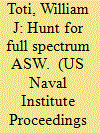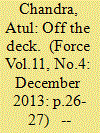|
|
|
Sort Order |
|
|
|
Items / Page
|
|
|
|
|
|
|
| Srl | Item |
| 1 |
ID:
132189


|
|
|
|
|
| Publication |
2014.
|
| Summary/Abstract |
An antisubmarine warfare doctrine adopted U.S. Navy-wide nearly a decade ago still applies, now more than ever.
During the Cold War, the U.S. Navy (particularly the submarine force) specialized in and excelled at antisubmarine warfare against the Soviet Union. But with the demise of the Soviets, ASW was put on the back-burner as an activity irrelevant to modern conflict. Over a decade passed before submarines would again be considered a serious threat to national security. During that time the nature of the submarine threat changed, so when the Navy "rediscovered" ASW, it learned that traditional, sensor-based methods of fighting against submarines, while important, could no longer ensure victory. To respond to this new threat, a new approach emerged in 2005, one that became known as "Full-Spectrum ASW." Quickly adopted as Navy doctrine, the concept pursued a more holistic approach to solving the submarine problem. This first-ever published treatise on the concept should explain how the doctrine was developed, in the hopes that a more thorough understanding of the concept will lead to better implementation.
|
|
|
|
|
|
|
|
|
|
|
|
|
|
|
|
| 2 |
ID:
125353


|
|
|
|
|
| Publication |
2013.
|
| Summary/Abstract |
New capabilities, new challenges : Peru's navy modernises for today and tomorrow
Guy Toremans reports on how Peru is building a future navy that will enable it to better address - both at home and further afield - a diverse range of traditional and emerging challenges with limited resources.
|
|
|
|
|
|
|
|
|
|
|
|
|
|
|
|
| 3 |
ID:
124671


|
|
|
|
|
| Publication |
2013.
|
| Summary/Abstract |
The induction of three vitally important types (MiG-29K, P-8I and Hawk Mk-132) into Indian naval aviation this year marks a resurgence of Indian naval air power in the region. Indian Naval Air Squadron (INAS) 303 'Black Panthers' was commissioned as the first MiG 29K squadron of the Indian Navy (IN) at INS Hansa in Goa in May this year (with 12 MiG-29K single seaters and four MiG-29KUB twin seaters). The same month saw the Indian Navy's first Boeing P-8I Long Range Maritime Reconnaissance (LRMR) and Anti-Submarine Warfare (ASW) aircraft arriving at NAS Rajali, at Arakkonam (in Tamil Nadu).
Last month, the IN inducted its first Hawk Mk-132 Advanced Jet Trainers (AJT) at NAS Dega. Hindustan Aeronautics Limited (HAL) has already delivered the first four jet trainers to the IN. The remaining 13 aircraft will be delivered over the next few years, completing the 17 aircraft order. The MiG-29 K/KUB and Boeing P-8I will enable the IN to provide credible and timely deterrence against its adversaries over the seas, while the induction of the first batch of BAE Hawk Mk-132 AJT will provide a state-of-the-art training environment for pilots transitioning to the MiG-29 Ks and much later the Light Combat Aircraft (LCA) navy fighter.
The MiG-29 K (single seat fighter) and MiG-29 KUB (twin seat fighter) multirole carrier borne fighter will provide the IN with a fighter that can strike both land and air targets and be used for long-range fleet air defence. Importantly, they will be able to commit to a much larger radius of action compared to the Sea Harriers, along with a substantially higher weapon load that can be delivered with much higher accuracy. Another fact that must be noted is the one can expect far more numbers of the MiG-29K to remain in service three decades from now, when compared to the notoriously difficult-to-fly Sea Harrier (which has suffered high attrition).
All 29 MiG-29 Ks on order (worth USD 1.5 billion) will be delivered by 2015 and currently 21 fighters have been delivered to the IN, the type having flown more than 2,500 hours since the first aircraft was inducted in February this year. The IN is the first user of the MiG-29 K; the Russian Navy has just become the second operator, taking delivery of its first four MiG-29K/KUB jets (two single-seat and two twin-seat) last month. Twenty MiG-29K and four MiG-29KUB fighters are to be delivered by 2015, and will be deployed on Russia's sole aircraft carrier 'Admiral Kuznetsov'.
|
|
|
|
|
|
|
|
|
|
|
|
|
|
|
|
| 4 |
ID:
124672


|
|
|
|
|
| Publication |
2013.
|
| Summary/Abstract |
Over the years the naval air arm has grown from a modest force to a full-fledged operational arm with an inventory of more than 200 aircraft. These include fighters, helicopters, maritime reconnaissance aircraft and Unmanned Aerial Vehicles (UAVs) with the capability to support the entire spectrum of maritime operations covering all dimensions of naval warfare. The navy's air arm operates from aircraft carriers, ships and a large number of naval airfields located across the Indian Littorals.
In May this year, naval aviation marked its 60 years of existence with the commissioning of its Air Squadron (Black Panthers) equipped with MiG 29K fighter jets for Carrier borne operations. This was followed by the induction of Boeing P-81 Poseidon MR-ASW aircraft and finally, in a historic development with far-reaching operational consequences, the Indian Navy took delivery of INS Vikramaditya. The acquisition of this 44,570 tonne carrier marks a new phase in India's quest to become a true blue water navy and is likely to have generated more than a passing interest within the People's Liberation Army Navy (PLA Navy) and across the rest of the Continent. These developments will place the Indian Navy at par with Russian and US navies as far as hardware is concerned.
In the fighter jet category for operating out of aircraft carriers, the naval aviation has two squadrons of the Sea Harrier which operate from INS Viraat. These were acquired by the Indian Navy in the mid Eighties and these jets had also operated ex INS Vikrant. Action was initiated to get additional Sea Harrier jets from Britain when the same were decommissioned by the Royal Navy, but the proposal did not fructify due to technical glitches. The proposal for a mid-life upgrade in the late Nineties was cancelled when the decision was taken to purchase MiG-29K jet fighters to be deployed aboard the INS Vikramaditya.
As the Harriers are expected to remain in service with the navy till 2015, limited upgrades are being done by Hindustan Aeronautics Limited (HAL). The indigenously produced Kiran (jet fighter trainer), which is currently being used for training, is likely to be phased out following the induction AJT Hawk jet trainers. The Kirans have been part of the elite Naval Aerobatic Display Team, 'The Sagar Pawans'.
In the Long Range Maritime Reconnaissance stream, the navy presently operates eight Tupolev Tu-142 aircraft which entered service in 1988. Upgrade of the aircraft is in process to extend its service life. These aircraft operate from INS Rajali and INS Hansa. In the Medium Range category, the navy has the Islander aircraft inducted into the navy in 1976 - these aircraft are vintage and need immediate replacement. In the Short Range category, the navy operates the HAL-built Dornier aircraft which continues to meet the surveillance and reconnaissance requirements of the navy.
Helicopters form a key element of a naval fleet at sea due to its ability to easily operate from frigate size ships and carry out diverse roles from anti-submarine warfare (ASW) to electronic warfare (EW), airborne early warning (AEW) and search and rescue (SAR). The Indian Navy operates a helicopter fleet consisting of the Sea King (ASW), Kamov 28 and 31 (ASW) and the modified Chetak-MATCH (Mid Air Torpedo Carrying Helicopter). In addition, they have a fleet of Chetak helicopters for shipborne operations. These helicopters are old and need replacement/upgrades. The HAL manufactured Dhruv (naval variant) was inducted into the air arm in March 2002. However, the navy found the Dhruv unsuitable for its role as an ASW platform. The Kamov-31 AEW helicopters acquired from Russia in the Nineties has proved to be a versatile platform for airborne operations at sea; more numbers are likely to be inducted.
|
|
|
|
|
|
|
|
|
|
|
|
|
|
|
|
|
|
|
|
|